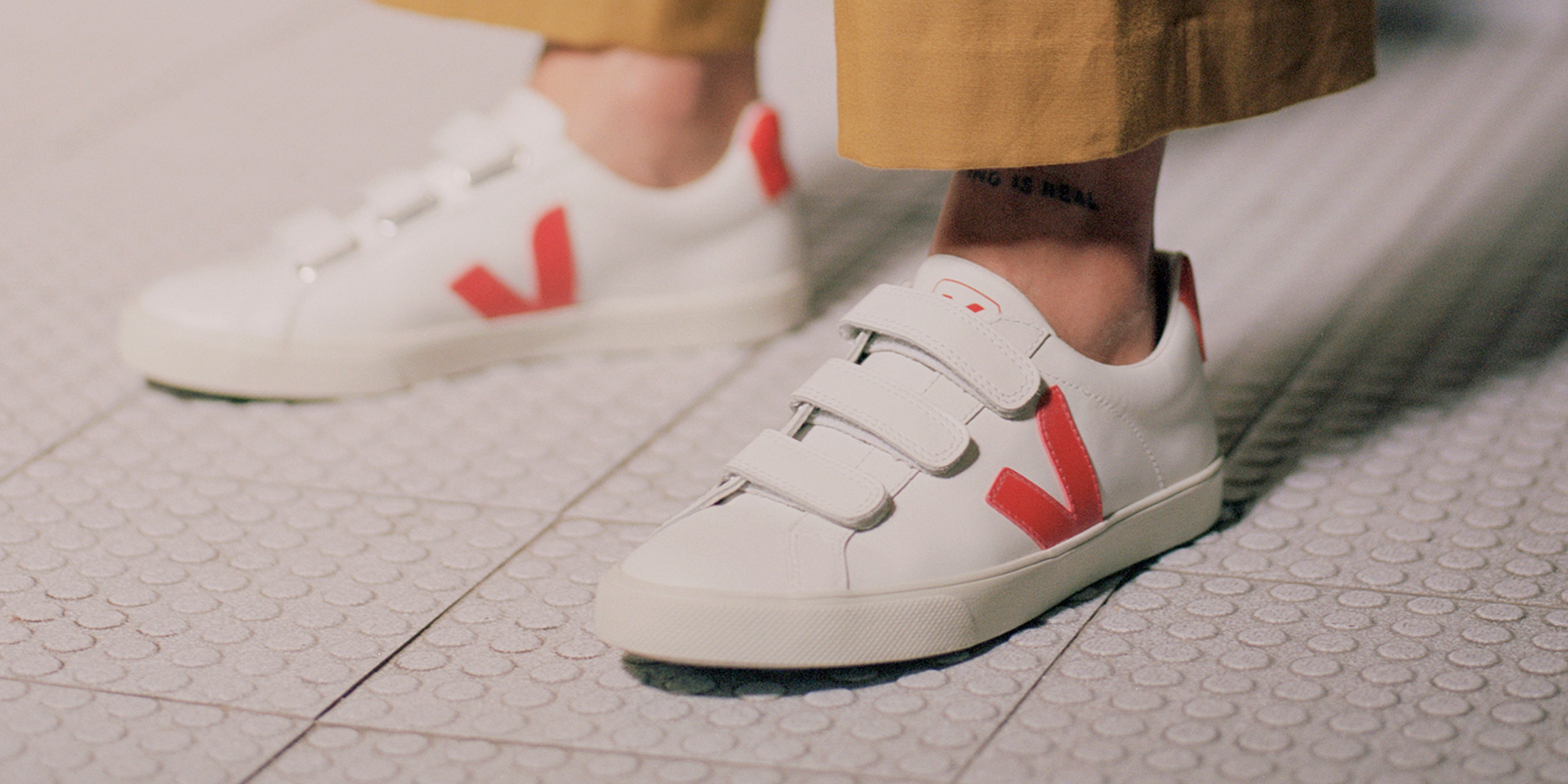There’s no simple switch any individual brand, no matter how large, can flip to magically “decarbonise” itself. But that doesn’t mean it’s impossible, either, as journalist Megan Doyle writes in this month’s Industry Insider column. In fact, the industry already has the ability. What it lacks is collaboration in the stages of manufacturing where nobody can agree who should actually pay to get the job done.
So far, fashion is failing to address its climate impacts
Last month, the Good On You team scoured data on thousands of fashion brands, big and small, to understand how they fared on major planetary impacts. The result was the Fashion Planet Benchmark report, which illustrated in 15 graphs the industry’s progress on everything from water reduction to circularity initiatives.
As I worked closely with the Good On You team to bring the report to life, what struck me as the clearest concern was fashion’s apparent inattention to climate change. As the data made clear, not only are most fashion brands not effectively reducing emissions in their supply chain, they’re also not measuring or disclosing status against their targets if they even have them.
The report uncovered that only 44% of brands have actually set emissions reduction targets, a small fraction of which are Science Based Targets. And among those that have targets, only 12% are disclosing progress on them. Not only is fashion failing to reduce its overall emissions, but in some cases they’re actually increasing. Fashion Revolution’s 2024 What Fuels Fashion report identified that 42 out of 250 brands actually increased their Scope 3 emissions last year.
The risks are also commercial: “Without stronger action and systemic changes, the industry risks losing the trust of consumers, investors, and regulators,” Sandra Capponi, co-founder of Good On You, told me last month.
These results raised a number of questions for me. What is preventing fashion’s biggest brands from making progress here? Is it really that difficult to decarbonise, or are brands deliberately kicking the can down the road despite knowing the solutions to their carbon problems?
It’s worth framing this conversation by acknowledging that the challenges brands face are complex. Coupled with the challenging economic outlook, tariff chaos, and commitment rollbacks that brands and suppliers are navigating, decarbonisation is unlikely to be at the top of many brands’ priority lists right now. There is no silver bullet that can reduce a brand’s emissions dramatically, but crucially, there are a wide variety of solutions available to brands that want to actually meet their targets. Some leaders in the space are working with their key suppliers and collaborators to replace coal boilers with electric, invest in wind farms, upgrade carbon-intensive machinery, and unlock financing incentives for low-emissions production, proving the barrier is not a lack of solutions; it’s a lack of ambition and commitment. Let’s dive into the key challenges that brands face in their decarbonisation journeys, and the pathways that could unlock meaningful impact.
Problem: Brands don’t directly control the most carbon-intensive parts of their supply chains
Brands generate emissions by burning fossil fuels at different stages of clothing production, but tier two—the material manufacturing phase—is where around 55% of carbon emissions are generated, according to 2024 data from the Apparel Impact Institute (Aii). The challenge is this: 93% of brands (according to the Fashion Planet Benchmark report) don’t know who is making their materials. Therefore, they don’t always know how those materials are being produced, or critically, what types of energy are used by facilities. As a result, only 4% of brands are taking steps to reduce these emissions.
“If you own your supply chain, you decide what is going to happen in the manufacturing plants,” explains Lutz Walter, secretary general of the European Technology Platform for the Future of Textiles and Clothing and founder of Think Innovation Consultancy. “But if you don’t own them, you don’t have much influence. Even big brands often are only representing a small percentage of the production of each factory they source from, so the impact they have is quite indirect.”
93% of brands don’t know who is making their materials, so they don’t always know how those materials are being produced.
That, however, is not an excuse for inaction. Fashion supply chains are typically built on short-term relationships dictated by brands, where they have all the purchasing power—they tend to control the terms of agreements with suppliers and manufacturers, and will negotiate the best price possible for their bottom line. Often, brands will drop a supplier that isn’t able to meet their price demands, leaving factories vulnerable to their whims and ever-tightening budgets.
“The reality is that the type of projects necessary for decarbonisation in this sector take long-term investments and long-term planning,” says Kurt Kipka, chief impact officer at the Apparel Impact Institute. “In an industry where a brand and suppliers’ outlook of businesses may be a year in advance, it’s difficult for a supplier to make a long-term investment or a brand to have a conversation around long-term investment in the types of activities that would bring about decarbonisation.” Simply tracing the supply chain of one product back to its raw material might take years of investigative work by brands, and that’s before they can even figure out the carbon-intensive processes that need reduction strategies.
Adding to the complexity, brands don’t have control over the national energy mix in their key production regions. Manufacturers will use the energy source that is most readily available and affordable to them, so decarbonisation strategies in Indonesia may look different to Pakistan, which is experiencing what the World Economic Forum described as a “solar power boom”.
Brands can, however, assess production partners and regions for their capacity to shift to renewables. Walter expects that brands will increasingly consider the carbon-intensity of production when making sourcing decisions, with those leaning into renewables expected to have a competitive advantage over coal-reliant producers.
It’s all about long-term, committed, and fair partnerships between brands and suppliers
Every sustainability summit bangs on about “collaboration”, and when it comes down to it, that is what fashion really needs to decarbonise. But it’s not happening at the scale or speed we need to make progress on the climate. That’s partly because this, too, is complicated due to how hard it can be to trace the supply chain for a single garment.
Indeed, to enable long-term relationships to form, brands have to know their suppliers, so establishing a map of supply chains is the first step. In recent years, the industry has been flooded with a huge variety of traceability tech companies that can help brands with complex, wide-reaching supply chains to connect the dots from the raw material through to the finished goods. This is a time-consuming but necessary phase that many brands are currently in, says Walter. “A lot of brands have been very busy understanding the problem first,” he explains. “In mapping your supply chain and finding out where all these [carbon] hotspots are, they won’t yet see results, but it’s a very important preparation work that brands have to do.”
Once brands establish who their key supply chain partners are, they can apply both a “carrot” and a “stick” approach to getting them on board with their decarbonisation goals. Put simply, the carrot is an incentive, like brands paying a premium for lower carbon products and materials, enabling access to low-cost financing by implementing energy efficiency targets, or making long-term buying commitments that give the supplier the financial security it needs to invest in upgrades like solar panels for their facility or new machinery that runs on electricity instead of coal. Implementing an upgrade that temporarily disrupts production is a hit not all suppliers are willing to take without a clear incentive. The stick is a disincentive—a brand can establish a set of requirements and targets that their suppliers must meet in order to remain part of the brand’s supply chain. For example, in 2022, H&M stopped onboarding new suppliers if they still used coal boilers. “With this type of approach, a brand better be ready to provide support in the way of funding, resources, even guidance at times,” says Walter. “Because unless there’s a clear strategy or a business case in place for that supplier to take that approach, it’s not aligned with their business objectives.”
Once brands establish who their key supply chain partners are, they can apply both a 'carrot' and a 'stick' approach to getting them on board with their decarbonisation goals.
Establishing long-term relationships with suppliers can be difficult for a number of reasons, but fashion’s fundamentally trend-led nature is a huge self-imposed barrier for brands whose business models rely on generating a constant desire for newness. If your long-term supplier doesn’t have the capability to produce the hot new style your customer wants, how do you navigate this? “If it’s not possible for a brand to commit to a single supplier long-term, what we’re encouraging is for a brand to commit to a type of supplier or a supplier profile,” says Kipka. “They could commit to a pool of suppliers, and in doing so, create a longer-term business case for a supplier, knowing that a set of brands will be purchasing products from them if they meet certain criteria.”
The trillion-dollar question: Who picks up the bill?
Perhaps the biggest barrier to decarbonisation is the price tag. In 2021, Fashion For Good put the total cost at $1.04 trillion to get fashion to net-zero by phasing out coal, scaling preferred and next-gen materials, and converting to renewables. How accurate is that number? It’s hard to know for sure, but clearly the general sense from most experts is that it’s not cheap.
If a brand only buys a small percentage of one factory’s output, it would argue against having to take on the financial burden of the factory’s decarbonisation. And most suppliers, already squeezed by brands, don’t have the financial runway to make this investment unsupported.
But not decarbonising is arguably more expensive in the long run. It is important to establish the business case for brands: decarbonisation will actually save money.
“The good thing about decarbonisation is that it’s not just shifting the energy source, it’s also saving energy. And saving energy saves you money,” says Walter. “And I believe as those technologies, like electric boilers and heat pumps become more affordable, producers will opt for them because they make economic sense. It’s an investment that has real economic return beyond decarbonisation.”
While inaction might give brands a short-term saving, the threat to their long-term supply chain resilience is real. A 2023 report from Cornell University’s Global Labor Institute and Schroders estimated that $65 billion worth of apparel exports from key sourcing regions could be at risk by 2030 if extreme heat and flooding (caused by carbon emissions) weren’t addressed. It’s in a brand’s financial interest, therefore, to invest in decarbonisation and protect their future access to materials and suppliers in high-risk regions.
The good thing about decarbonisation is that it's not just shifting the energy source, it's also saving energy. And saving energy saves you money
Lutz Walter – secretary general of the European Technology Platform for the Future of Textiles and Clothing; founder of Think Innovation Consultancy
Brands can help suppliers by unlocking financing through a range of pathways—from banks and private equity to philanthropic funds and governments—that can spread the financial burden between different stakeholders. In 2024, The Fashion Pact, Apparel Impact Institute and DBS Bank launched the Future Supplier Initiative—a brand-supported programme that provides both financial support and technical solutions to suppliers that will help them decarbonise. Others are tackling more systemic challenges, like the national energy makeup. In 2023, Global Fashion Agenda and Copenhagen Infrastructure Partners announced the Renewable Energy Initiative that will develop an offshore wind farm in Bangladesh, due to be operational in 2028, with investment commitments from Bestseller and H&M.
Decarbonisation remains in a logjam, but progress doesn’t need to be utopian
Fashion isn’t making enough progress on decarbonisation, but the business case and solutions exist. For those companies willing to put in the time, money, and energy into reducing their reliance on fossil fuels, the roadmap exists to get them there. “There are so many organisations, resources available, projects and programmes that exist out there,” says Kipka. In fact, Aii recently published a new report that outlines financing models for decarbonisation in Bangladesh. In March, Fashion For Good launched the Future Forward Factory, an open-source prototype that will demonstrate new and existing decarbonisation solutions for brands and tier two manufacturers to adopt. NGO Future Earth Lab has an interactive Sustainability Initiatives Map for brands to locate programmes in their sourcing regions. “There’s no reason to go it alone,” says Kipka.
And ultimately, we need to think pragmatically—systems change doesn’t happen overnight, but by taking small steps in the right direction. “I don’t think we should expect any miracles, but I’m really convinced that we’ll see this gradual process,” Walter says. “There are so many factors working towards decarbonisation, and they all add up.”



















